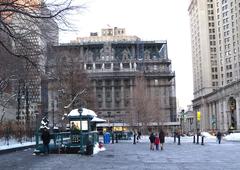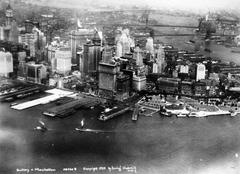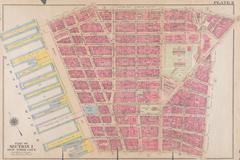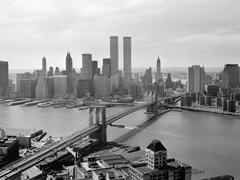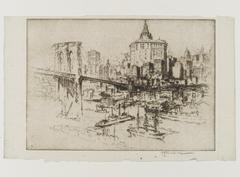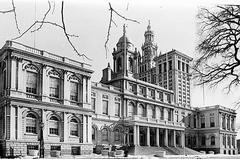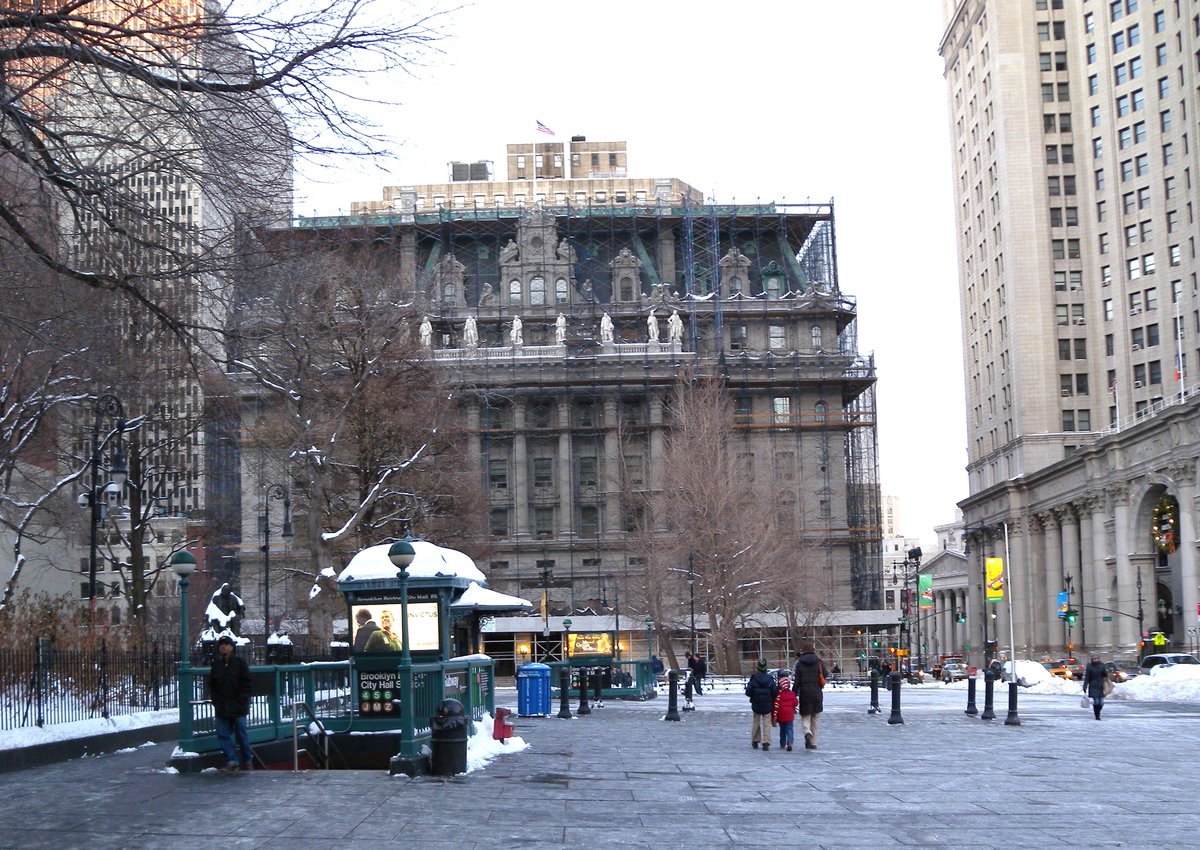
Manhattan Municipal Building Visiting Hours, Tickets, and New York City Historical Sites Guide
Date: 14/06/2025
Introduction
The Manhattan Municipal Building, officially named the David N. Dinkins Manhattan Municipal Building, stands as a monumental testament to New York City’s civic history and Beaux-Arts architectural excellence. Located at 1 Centre Street in Lower Manhattan’s Civic Center, it is a centerpiece of government activity and a beacon for architecture enthusiasts and history lovers alike. From its grand arches and the gilded “Civic Fame” statue to its innovative integration with the subway, the building represents the city’s rapid early 20th-century growth, urban planning ingenuity, and enduring civic pride (CTBUH; 6sqft; Untapped Cities; Manhattan Borough President’s Office).
This comprehensive guide details everything you need to know for your visit—including opening hours, entry policies, accessibility, highlights, and tips for making the most of your exploration of one of New York City’s most significant historical sites.
Table of Contents
- Introduction
- Beaux-Arts Design and Symbolism
- Structural Innovations and Engineering Challenges
- Influence on Civic Architecture
- Notable Architectural Features
- Interior Layout and Functional Design
- Visiting Hours, Tickets, and Accessibility
- Entrance & Security
- Travel Tips and Nearby Attractions
- Special Events and Guided Tours
- Visuals and Multimedia Suggestions
- Frequently Asked Questions (FAQ)
- Conclusion and Call to Action
- References
Beaux-Arts Design and Symbolism
The Manhattan Municipal Building is a preeminent example of Beaux-Arts architecture, designed by the renowned firm McKim, Mead & White and completed in 1914. Its grand scale, symmetry, and elaborate ornamentation—including monumental arches, classical columns, and sculptural reliefs—reflect the City Beautiful movement’s ideals of civic grandeur and urban order (6sqft).
The building’s five cupolas symbolize the five boroughs, celebrating the 1898 consolidation of New York City. Crowning the structure is Adolph A. Weinman’s 25-foot gilded copper “Civic Fame” statue, the third-largest statue in the city and an enduring emblem of New York’s unity and ambition.
Structural Innovations and Engineering Challenges
Constructed on a site where bedrock lies unusually deep (over 200 feet below ground), the building required pioneering engineering techniques. Workers used pressurized caissons and concrete to stabilize the foundation, enabling the massive, 580-foot-tall structure to rise above the city (6sqft). It was one of the first skyscrapers anywhere to integrate a subway station directly into its base, demonstrating early 20th-century innovation in urban infrastructure.
Influence on Civic Architecture
The Manhattan Municipal Building set a new standard for civic architecture. Its blend of monumental classical forms and functional modern design influenced later government buildings nationwide, such as Chicago’s Wrigley Building and Cleveland’s Terminal Tower. The design, selected through a competitive process, underscored an era of architectural ambition and civic pride (6sqft).
Notable Architectural Features
Central Arch and Façade
The building’s central arch, inspired by Rome’s Arch of Constantine, is flanked by massive columns and adorned with allegorical sculptures. Once open to automobile traffic, the arch now serves as an impressive pedestrian gateway and photographic focal point.
Guastavino Tile Vaults
The South Concourse features Guastavino-tiled vaults, exemplifying early 20th-century craftsmanship. These interlocking terracotta tiles not only create elegant structural forms but also connect the building seamlessly to the Chambers Street subway station (6sqft).
Civic Fame Statue
Atop the main tower, “Civic Fame” stands watch, holding a crown with five turrets, a shield, and a branch—symbols of the city’s unity, protection, and peace.
Interior Layout and Functional Design
Designed to accommodate New York City’s rapidly expanding municipal government, the building houses over a dozen city agencies and approximately 3,000 employees. With 2,000 windows, 33 elevators, and 73 restrooms, its layout balances ceremonial spaces and practical office environments (6sqft).
Visiting Hours, Tickets, and Accessibility
Hours:
Open to the public Monday–Friday, 8:30 AM to 5:00 PM (some sources note 9:00 AM opening; check ahead for current hours).
Entry & Tickets:
Admission is free. Access to the building is generally limited to those with official business or appointments, such as visiting the City Clerk’s Office or other agencies. There are no general tickets required, but special events (like Open House New York) may offer free ticketed access to restricted areas such as the cupola (Untapped Cities).
Accessibility:
The building is fully accessible, with ramps, elevators, and accessible restrooms. For special accommodations, contact the Office of the Manhattan Borough President or the Department of Citywide Administrative Services in advance.
Entrance & Security
Visitors typically enter via the Guastavino-tiled side entrance near Chambers Street station. All guests must pass through security screening (metal detectors, bag checks) and present a government-issued photo ID. Allow extra time during peak hours or if attending public meetings or ceremonies.
Travel Tips and Nearby Attractions
-
Transportation:
- Subway: Chambers Street station (A, C, J, Z, 1, 2, 3, 4, 5, 6, R, W) is directly beneath or adjacent to the building.
- Bus: Multiple MTA lines stop nearby.
- Parking: Street parking is extremely limited; use nearby garages or public transit for convenience.
-
Nearby Landmarks:
- City Hall and City Hall Park
- Brooklyn Bridge
- Woolworth Building
- New York County Courthouse
- Chinatown, Tribeca, and South Street Seaport
-
Dining:
- No dining facilities in the building; excellent options abound in Chinatown and Tribeca (Trip.com).
Special Events and Guided Tours
While there are no regular public tours, special access is occasionally offered during events like Open House New York or through local historical organizations. These tours may include visits to the cupola with panoramic city views and expert commentary on the building’s history and architecture. Check event calendars and register early, as spots fill quickly (Untapped Cities).
Visuals and Multimedia Suggestions
-
Photography:
The plaza, central arch, and “Civic Fame” statue are excellent for photos, especially in the morning or late afternoon. Photography in public spaces is permitted; avoid shooting in restricted office areas. -
Multimedia:
Virtual tours, interactive maps, and high-resolution images are available via the NYC Department of Citywide Administrative Services and other official sites. Alt text suggestions: “Manhattan Municipal Building façade showcasing Beaux-Arts architecture,” “Civic Fame statue atop Manhattan Municipal Building,” “Guastavino tile vaults in the South Concourse.”
Frequently Asked Questions (FAQ)
Q: What are the Manhattan Municipal Building’s visiting hours?
A: Monday through Friday, 8:30 AM to 5:00 PM. Check ahead for holiday schedules.
Q: Is there an admission fee or are tickets required?
A: No; entry is free, but access is generally for those with official business or appointments.
Q: Is the building wheelchair accessible?
A: Yes, including elevators and accessible restrooms.
Q: Are guided tours available?
A: Not regularly. Special events like Open House New York occasionally offer tours (advance registration required).
Q: How do I get there by public transport?
A: Multiple subway lines serve Chambers Street station, which is integrated into the building.
Q: Can I visit the cupola or rooftop?
A: Access is limited to special events.
Q: Where is the Marriage Bureau?
A: Inside the building; open to residents and visitors for civil ceremonies.
Conclusion and Call to Action
The Manhattan Municipal Building is a living symbol of New York City’s civic legacy and architectural brilliance. Whether you’re seeking historical insight, architectural wonder, or simply an efficient way to access city services, planning your visit here enriches any exploration of Lower Manhattan. For more in-depth guides, up-to-date hours, and recommendations on nearby historical sites, download the Audiala app and follow our social media channels. Don’t miss special events like Open House New York for rare behind-the-scenes access!
References
- Manhattan Municipal Building. Council on Tall Buildings and Urban Habitat (CTBUH). (CTBUH)
- Video: The Fascinating History of the Manhattan Municipal Building. 6sqft, 2023. (6sqft)
- Top 11 Secrets of NYC’s Manhattan Municipal Building. Untapped Cities, 2024. (Untapped Cities)
- Manhattan Borough President’s Office Official Website, 2024. (Manhattan Borough President’s Office)
- Hidden Architecture. (Hidden Architecture)
- Trip.com. (Trip.com)
- New York Dearest. (New York Dearest)
